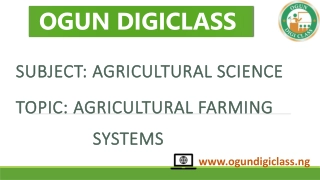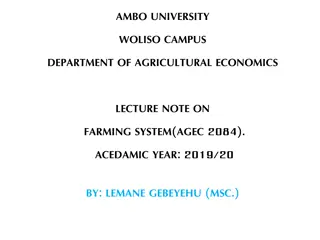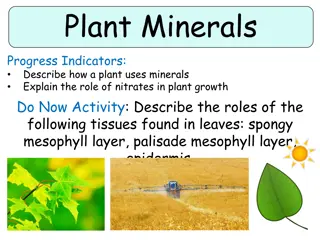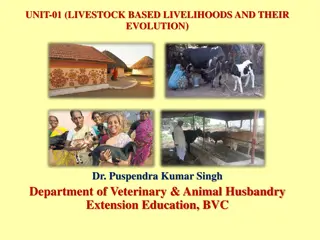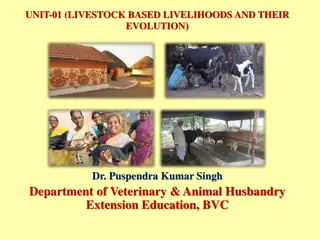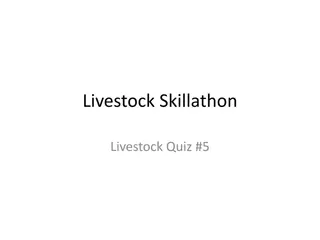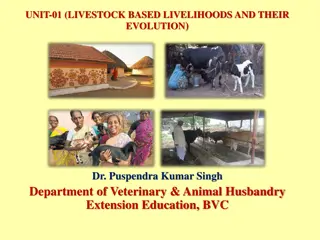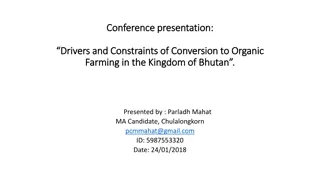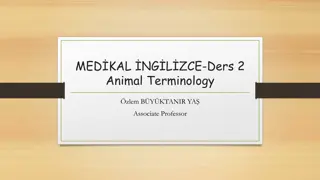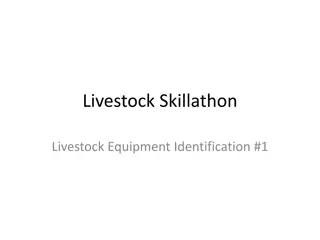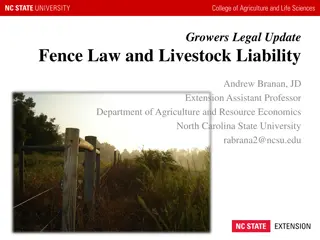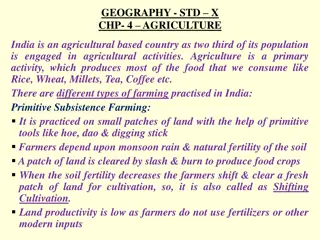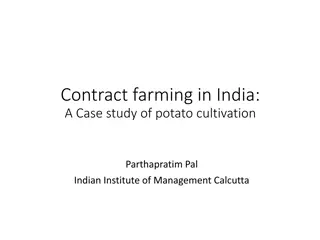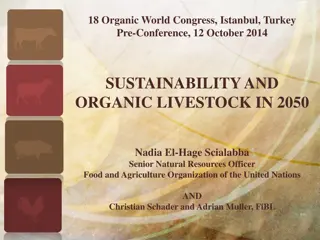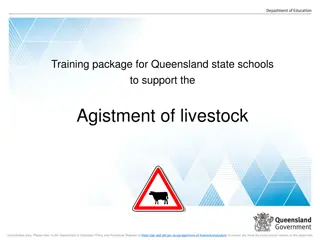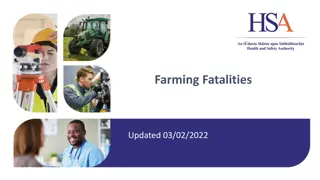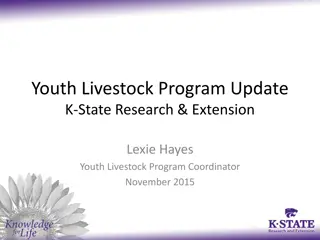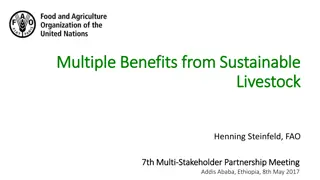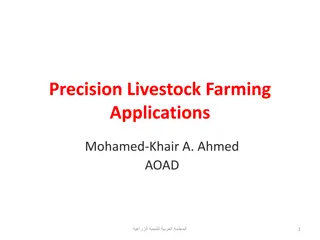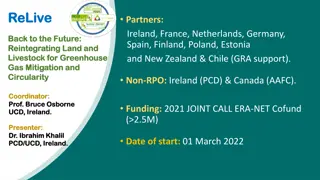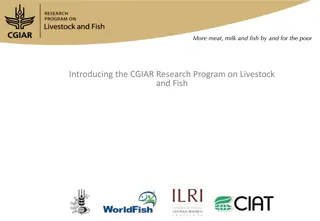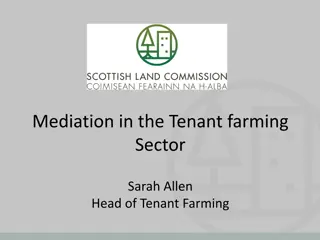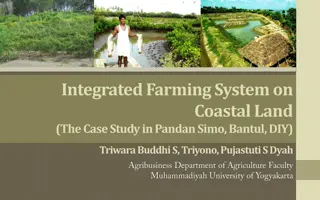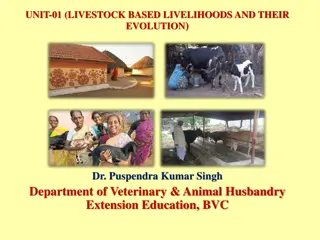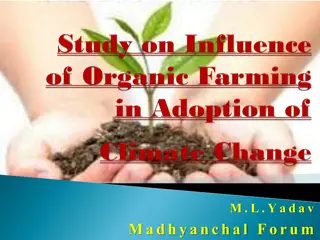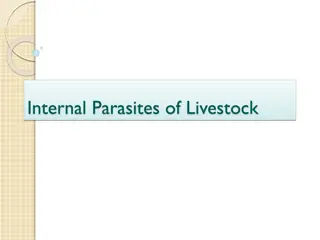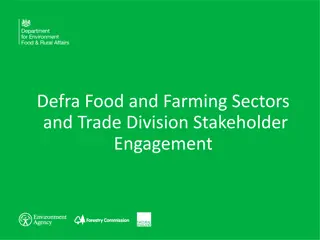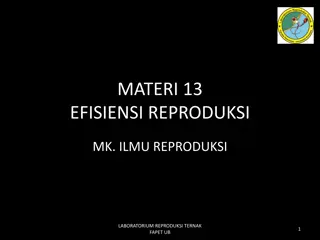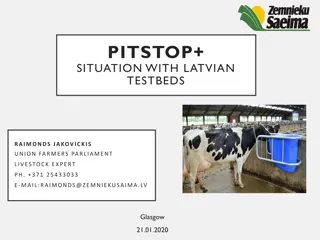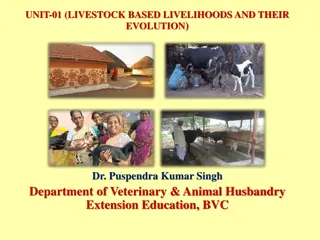OGUN DIGICLASS
Farming has evolved over time from gathering to planting and rearing livestock, leading to various agricultural farming systems. Factors like water, land, climate, and landscape influence these systems. Subsistence production, one such system, focuses on personal and family consumption, utilizing av
1 views • 28 slides
Understanding Farming Systems in Agricultural Economics
Concepts of farming systems research and development are crucial for effective agricultural management. A farming system encompasses various components that work together to achieve specific objectives. It involves the arrangement and management of farming enterprises in response to environmental fa
0 views • 49 slides
Organic vs Conventional Farming: An Overview
In the debate between organic and conventional farming, both methods have their pros and cons. While organic foods are perceived to follow stricter safety standards, both types meet FDA and USDA regulations. They offer similar nutritional value, but organic farming tends to have lower efficiency due
0 views • 6 slides
Plant Minerals and Farming Methods
Learn about how plants use minerals for growth, the role of nitrates, different leaf tissues, mineral deficiencies, and farming methods to ensure crop yield. Discover how plants obtain minerals from the soil, symptoms of mineral deficiencies, and the importance of fertilizers in farming. Explore dif
0 views • 13 slides
Overview of Livestock Production: Cattle, Sheep, and Goat Breeds
Explore the diverse world of livestock production, including cattle ranching, dairy farming, hog and pig farming, poultry and egg production, and animal aquaculture. Delve into the specifics of sheep and goat production, from breeds and production systems to management practices, breeding techniques
1 views • 43 slides
Diverse Methods of Poultry Farming and Agricultural Practices
Poultry farming practices such as organic farming, nitrogen fixation, biodiversity management, and contract farming are discussed. Organic farming emphasizes holistic relationships in agriculture, promoting sustainable production. Nitrogen fixation and biodiversity management play essential roles in
0 views • 20 slides
Evolution of Livestock-based Livelihoods and Capitalistic Farming Systems
Livestock-based livelihoods have evolved over time, with capitalistic farming systems emerging as prominent in regions like South America, North America, and Europe. These systems are characterized by individual entrepreneurs controlling farming activities. Plantations are a common example of capita
0 views • 10 slides
Livestock-based Livelihoods and Farming Systems Evolution
Livestock-based livelihoods and farming systems have evolved over time, aiming to produce food and crops sustainably. Small-scale farming, farm management, types of farming, and various farming systems like specialized and diversified farming play key roles in enhancing productivity, profitability,
9 views • 19 slides
Livestock Skillathon Quiz Challenge
Test your knowledge of livestock with this interactive quiz. Learn about cattle breeds, common diseases, breeding techniques, and terminology related to raising and caring for livestock. Challenge yourself and expand your understanding of the livestock industry.
0 views • 12 slides
Contract Farming in India: A Case Study of Potato Cultivation
Value addition in Indian agriculture is low due to poor processing levels. Contract farming is being considered to integrate agriculture production into the global value chain, but concerns about unequal bargaining power between farmers and corporations exist. Various forms of contract farming exist
0 views • 26 slides
Evolution of Livestock-Based Livelihoods in Peasant Farming
Livestock-based livelihoods have evolved significantly in peasant farming, where individual farmers own, manage, and organize their entire farms. Advantages include better supervision, increased employment opportunities, greater productivity, and quick decision-making abilities. However, challenges
0 views • 6 slides
Exploring Drivers and Constraints of Conversion to Organic Farming in Bhutan
Population in Bhutan heavily relies on agriculture, but the transition to organic farming has been slow despite the desire to reduce chemical use. This presentation investigates the current state of organic farming, identifies key factors affecting conversion, and offers policy recommendations to pr
0 views • 22 slides
Animal Terminology in Livestock Farming
Animal terminology in livestock farming includes terms like breed, dam, flock, herd, livestock, polled, sire, litter, chickens, cattle, ducks, and goats. Understanding these terms is essential for those involved in animal husbandry and farming. This comprehensive guide provides definitions and expla
1 views • 18 slides
Livestock: Key Driver for Sustainable Agricultural Development
Livestock plays a crucial role in sustainable agricultural development by driving land use, consumption, and serving as a powerful engine for food systems. The focus on livestock is essential for exploring pathways towards Sustainable Agricultural Development (SAD) and addressing challenges related
1 views • 24 slides
Livestock Equipment Identification for Skillathon Participants
Explore a comprehensive guide on livestock equipment identification for skillathon participants. From all-in-one castrators to fencing pliers, this resource includes detailed descriptions and images of essential tools used in livestock management tasks such as artificial insemination, dehorning, and
0 views • 8 slides
Legal Update on Fence Law, Livestock Liability, and Zoning Regulations
Understanding the legal aspects of fence laws, livestock liability, and zoning regulations is crucial for growers and farmers. This update covers key points such as personal liability limits, compliance with exemptions, and the implications of livestock escaping. It also delves into boundary fencing
0 views • 28 slides
Agricultural Practices and Major Crops in India
India is predominantly an agricultural-based country with two-thirds of its population engaged in farming. The country practices different types of farming, including primitive subsistence farming, intensive subsistence farming, and commercial farming. The cropping seasons in India are classified as
0 views • 8 slides
Livestock Economics and Marketing: Understanding Markets and Classification
Livestock markets are essential for the buying and selling of livestock and related products. Markets can be classified based on various factors such as location, nature of commodities, time span, and more. Understanding the essentials of markets, livestock market components, and classification help
0 views • 18 slides
Contract Farming in India: Enhancing Agricultural Value Chain Through Partnerships
Value addition in Indian agriculture has been low due to limited processing levels. Contract farming is emerging as a viable solution to integrate agriculture production into the global value chain, albeit with concerns about unequal bargaining power. Various forms of contract farming exist, with ex
0 views • 26 slides
Sustainability and Organic Livestock Modeling for Global Food Security
The research presented at the 18th Organic World Congress in Istanbul delves into the Sustainability and Organic Livestock (SOL-m) modeling approach developed by FAO and FiBL. The study aims to explore the potential impacts of global conversion to organic livestock production by 2050 on food securit
0 views • 25 slides
Agistment of Livestock Training Package for Queensland State Schools
This training package provides guidance for Queensland state schools on agisting livestock, covering topics such as governance, livestock management, legislation, and ethics. It emphasizes the responsibility of schools in managing livestock, including educational and commercial arrangements, with a
0 views • 20 slides
Analysis of Farming Fatalities: Trends and Insights 2012-2021
This in-depth analysis delves into farming fatalities data from 2012 to 2021, highlighting the causes, demographics, and patterns of such tragedies. The content provides a comprehensive overview of fatalities on farms, including fatalities involving vehicles, livestock, falls, machinery, and heavy l
0 views • 11 slides
Youth Livestock Program Update & Overview
Youth Livestock Program Update features activities like Junior Producer Days, Discovery Days, and the Nomination Process conducted by K-State Research & Extension. The program aims to educate participants on selection, nutrition, care, and showmanship of livestock. Events include educational program
0 views • 14 slides
Virginia Livestock Programs and Opportunities for Youth
Explore a variety of exciting opportunities in the Virginia 4-H Livestock Programs, including state-sponsored events, contests, and educational exhibitions for youth interested in livestock agriculture. From livestock judging to cattle working contests, these programs provide valuable experiences fo
0 views • 34 slides
Intelligent Livestock Health Management System in Rural Bangladesh
Livestock farming is vital for rural families in Bangladesh, but faces challenges like scarcity of veterinarians and affordable services. To address this, the Intelligent Livestock Health Management System was developed using a smart phone application called Livestock Monitoring System (LMS). LMS pr
0 views • 12 slides
Sustainable Livestock and Future Generations
Sustainable development aims to meet present needs without compromising the ability of future generations to meet their own. Cooperation and responsible resource management, particularly in livestock farming, play crucial roles in ensuring a balanced ecosystem and socio-economic prosperity. The conc
0 views • 32 slides
Advancing Livestock Farming Through Precision Technology
Precision Livestock Farming (PLF) utilizes automated real-time monitoring to enhance production, reproduction, health, and welfare of animals. By measuring animal and environmental variables, utilizing predictive models, and integrating data for decision-making, PLF offers benefits such as improved
0 views • 28 slides
ReLive: Sustainable Livestock and Cropping Systems Integration for GHG Mitigation
ReLive project aims to holistically reintegrate livestock and cropping systems to mitigate greenhouse gases, focusing on livestock management, manure use, soil management, and decision support tools. Deliverables include farming databases, opinion papers, handbooks on Climate-Smart Agriculture, and
0 views • 4 slides
Accelerating Livestock and Aquaculture Development for Poverty Reduction
The CGIAR Research Program on Livestock and Fish aims to address the challenges and misconceptions surrounding livestock and aquaculture development. It focuses on increasing productivity in small-scale systems to benefit the poor and improve food security. The program seeks to correct misconception
0 views • 27 slides
Enhancing Mediation in the Tenant Farming Sector
Sarah Allen, Head of Tenant Farming, leads initiatives to promote mediation in the tenant farming sector, aiming to improve relationships between landlords and tenants. The Tenant Farming Commissioner under the Land Reform Act 2016 encourages mediation for resolving complex disputes. The pilot media
0 views • 9 slides
Innovative Agro-Farm Business Proposal for Sustainable Farming
Conceive and run large-scale agricultural projects employing cutting-edge technologies in farming operations and management. Our vision is to promote fairness, excellence, harmony, and sustainability while engaging in sustainable commercial farming of vegetables, fruits, and livestock. Collaborating
0 views • 44 slides
Integrated Farming System on Coastal Land: A Case Study in Pandan Simo, Bantul, DIY
The coastal area in Pandan Simo, Bantul, is embracing integrated farming systems combining food crops, horticulture, and livestock due to diminishing agricultural land. Farming on marginal lands like beaches has become a prevalent alternative. This case study aims to assess farming feasibility and r
0 views • 10 slides
Evolution of Livestock-Based Livelihoods: From Estate Farming to Specialized Crop Cultivation
Estate farming, a form of industrialized agriculture introduced by the British in the 19th century, involves large monocultures of cash crops like tea, rubber, and spices. It requires significant investment in modern farming techniques, machinery, and skilled labor. Estate farming is capital-intensi
0 views • 8 slides
Study on Climate Change and Organic Farming Impact by Madhyanchal Forum
Madhyanchal Forum conducted a study on the impact of climate change on agriculture and the effectiveness of organic farming in mitigating climate change. The study involved various organizations and farmers across different regions, focusing on the adoption of sustainable farming practices. Detailed
0 views • 16 slides
Understanding Internal Parasites of Livestock
Internal parasites of livestock, such as roundworms, tapeworms, and flukes, can have a significant impact on the health and productivity of animals. These parasites live within the internal organs of livestock, causing various symptoms and affecting different species. Roundworms, like stomach worms,
0 views • 30 slides
Sustainable Crop-Livestock Integration Case Study in Tanzania
Assessing and improving crop-livestock systems for sustainable intensification pathways in Tanzanian farming through case studies like Moshi Maile farm in Kongwa. The farm utilizes various techniques including agroforestry, intercropping, and livestock rearing to enhance productivity and resilience
0 views • 14 slides
Sustainable Farming Incentive Stakeholder Engagement Meeting
The meeting hosted by Defra's Food and Farming Sectors and Trade Division aims to gather feedback on the Sustainable Farming Incentive pilot standards and payment processes. Stakeholders in the Arable Sector can provide expert input to shape the development of the program, ensuring farmers' active p
0 views • 20 slides
Reproductive Efficiency in Livestock Production
Understanding the factors affecting reproductive efficiency in livestock, such as postpartum period, anestrus, and fertility indices in dairy cattle. Discover methods to enhance reproductive performance and the impact on successful farming practices. Explore the importance of timely calving interval
0 views • 16 slides
Latvian Testbeds in Livestock Farming with Raimonds Jakovickis
Situation analysis of Latvian testbeds managed by Raimonds Jakovickis, an expert in livestock farming, at the Union Farmers' Parliament. The testbeds at Ltd. MPS Vecauce involve testing cows equipped with electronic ear tags, with recent improvements in farm infrastructure and results reported in De
0 views • 8 slides
Evolution of Livestock-Based Livelihoods in Agriculture
Livestock-based livelihoods, including extensive farming, play a significant role in agriculture. Extensive farming involves minimal inputs of labor, capital, and fertilizers per unit of land. It commonly refers to sheep and cattle farming in low-productivity areas. The system relies on natural soil
0 views • 8 slides
